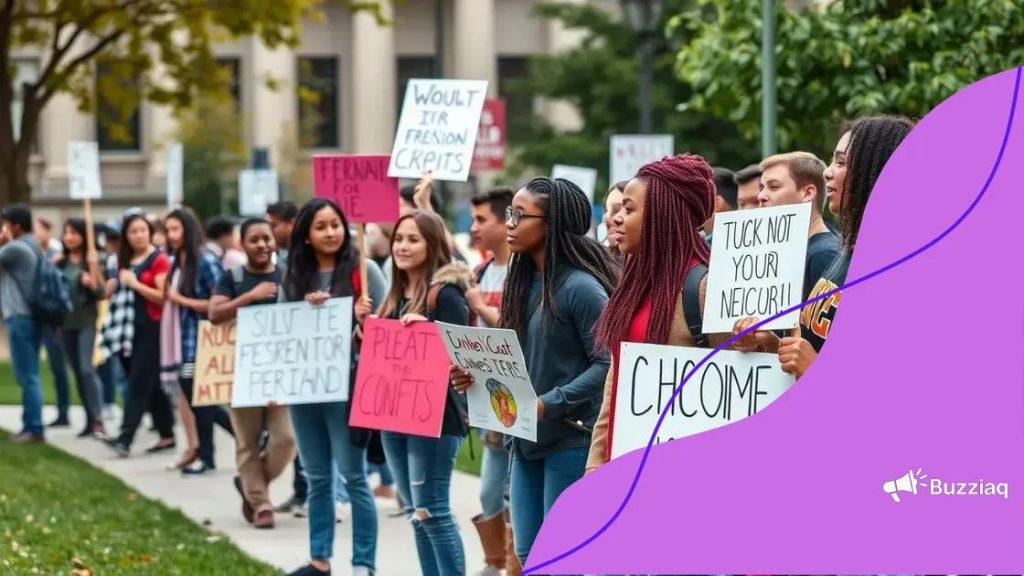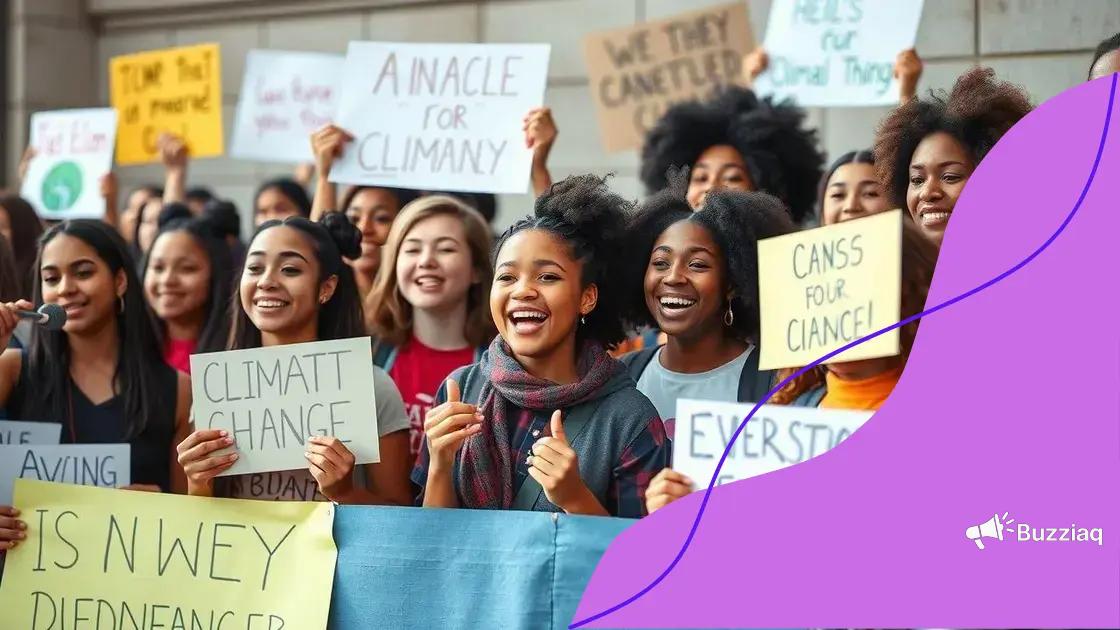Student activism and administrative responses: a closer look

AD
Student activism and administrative responses are interconnected, where social media empowers students to advocate for key issues like climate change and educational inequality while universities engage through open communication and collaboration.
Student activism and administrative responses are interwoven elements of campus life that shape educational landscapes. Have you ever wondered how universities handle student-led movements? This article takes a deeper dive into this dynamic relationship.
AD
Overview of student activism
When we talk about student activism, we refer to the efforts and actions taken by students to advocate for change. This activism can take many forms, from peaceful protests to campus organizations working on social issues. It’s important to understand how these movements influence educational institutions and society as a whole.
The history of student activism is rich and full of impactful moments. Throughout the decades, students have played a significant role in shaping policies and raising awareness about various issues that matter to them. Understanding their perspectives helps in addressing their concerns effectively.
The Role of Student Activism
Student activism serves various purposes, including:
AD
- Promoting social justice causes
- Advocating for educational reforms
- Raising awareness on environmental issues
By engaging in these activities, students not only express their opinions but also create a platform for dialogue between administration and the student body. This is vital in maintaining a healthy educational environment where voices are heard.
Impact on Society
The impact of student activism extends beyond the campus. When students mobilize, they not only advocate for their rights but also highlight broader societal issues. Their actions can lead to significant changes in legislation and public opinion.
Furthermore, social media plays a crucial role in amplifying their voices. Students can share their messages quickly, forming connections with others who support their causes. This digital presence helps to draw attention to issues that might otherwise go unnoticed.
Historical examples of activism
Throughout history, student activism has played a prominent role in various social movements. Understanding these historical examples illuminates how students have shaped the world around them.
One notable instance is the student protests during the Vietnam War in the 1960s and 70s. Universities across the United States saw waves of demonstrations against the war, with students advocating for peace and an end to military involvement. This activism was not just about individual campuses but sparked a nationwide movement.
Key Historical Movements
There are several pivotal moments in history that highlight the power of student activism:
- The Civil Rights Movement: Students from historically black colleges led significant protests for racial equality.
- The Tiananmen Square protests of 1989: Students in China demanded political reform and democracy.
- The March for Our Lives: In 2018, students rallied for gun control in the aftermath of the Parkland shooting.
These movements show the determination and passion of young people fighting for their beliefs
While many of these historical examples demonstrate the courage of students, they also highlight the risks involved. Activists often faced serious consequences, including arrests and backlash from authorities. Nevertheless, their actions paved the way for greater societal changes.
The influence of student activism continues today. Modern movements often borrow strategies from past efforts, proving that history remains a guiding force for current and future activists. By studying these examples, we can better understand the challenges and successes of students advocating for change.
Key issues driving student movements

There are several critical issues that drive student movements today. These concerns reflect the values and priorities of young people, pushing them to advocate for change in their communities.
One significant issue is climate change. Many students are passionate about protecting the planet and demand action from governments and institutions to combat environmental degradation. They organize events, protests, and campaigns to raise awareness about the urgency of this crisis.
Important Factors Influencing Activism
Another key issue is educational inequality. Students recognize that access to quality education is not equal for everyone. They advocate for reforms that ensure fair funding and resources for underfunded schools.
- Access to affordable tuition
- Diverse representation in curricula
- Support for mental health services
The struggle for racial equality also drives many student movements. Recent events have highlighted systemic racism, prompting students to demand justice and equality. They work together to ensure that their campuses are safe and inclusive for all.
Additionally, issues such as gun violence have mobilized students to take a stand. The aftermath of school shootings has led to calls for stricter gun control laws, with students advocating for their right to feel safe in their learning environments.
Each of these issues showcases the deep concerns students have for their future and their willingness to fight for their beliefs. Through organizing, protesting, and engaging with their communities, they contribute to a larger conversation about societal change.
Administrative strategies for engagement
Administrative strategies for engaging with students are essential for fostering a productive campus environment. When universities listen to their students, it creates a sense of community and trust.
One key strategy is the establishment of open communication channels. Universities can create forums or regular meetings where students can voice their opinions and concerns. This encourages students to participate actively, ensuring their needs are heard and addressed.
Developing Collaborative Programs
Another important approach is to develop collaborative programs between students and administration. This includes creating initiatives that allow students to work alongside faculty and administrators on various projects. Such collaboration can lead to a better understanding of student needs and challenges.
- Student advisory committees
- Joint workshops on pressing issues
- Internships that involve administrative processes
Additionally, universities can use technology to enhance engagement. Online platforms can facilitate discussions, feedback, and polls, making it easier for students to share their input regardless of their schedules.
Engagement also involves training for administrators to understand student perspectives better. Workshops on diversity and inclusion can help staff connect with the diverse student body, creating a more inclusive environment.
When students feel involved in decision-making processes, they are more likely to support initiatives that affect their education and campus life. This collaborative spirit not only enhances the student experience but also contributes to a positive university culture.
The impact of social media on activism
Social media has revolutionized the way student activism functions. It has become a powerful tool for students to organize, share information, and raise awareness about important issues.
Platforms like Twitter, Instagram, and Facebook allow students to connect with others who share their goals and passions. This connectivity makes it easier to mobilize support quickly for protests and campaigns, reaching a wider audience than traditional methods.
Key Benefits of Social Media for Activism
One significant benefit is the ability to spread information rapidly. Students can share updates, news articles, and their own stories in real time. This immediacy helps generate momentum for their causes.
- Raising awareness about events and issues
- Mobilizing supporters for rallies and campaigns
- Creating online communities around shared interests
Moreover, social media can amplify marginalized voices that traditional media might overlook. It gives students the power to highlight their struggles and achievements, garnering empathy and support from a global audience.
While social media has many advantages, it also presents challenges. Misinformation can spread just as easily as accurate information. Students must learn to discern reliable sources and think critically about the content they share. Additionally, online activism can sometimes feel less impactful than face-to-face engagement, leading to debates on the effectiveness of virtual versus physical presence in activism.
Ultimately, the impact of social media on student activism has transformed how young people engage with the world around them. It provides the tools and platforms necessary for collective action, making it a vital part of modern movements.
FAQ – Questions About Student Activism and Social Media
How has social media changed student activism?
Social media allows students to organize quickly, share their messages widely, and connect with like-minded individuals, increasing the reach and impact of their activism.
What are some key issues that drive student movements?
Students are often concerned with climate change, educational inequality, gun violence, and social justice, which inspire them to take action and advocate for change.
How can universities engage with student activists?
Universities can engage by creating open communication channels, establishing collaborative programs, and using technology to facilitate discussions and feedback.
What challenges do student activists face on social media?
Student activists may encounter misinformation, online harassment, and the struggle to maintain engagement in a digital space compared to physical presence.